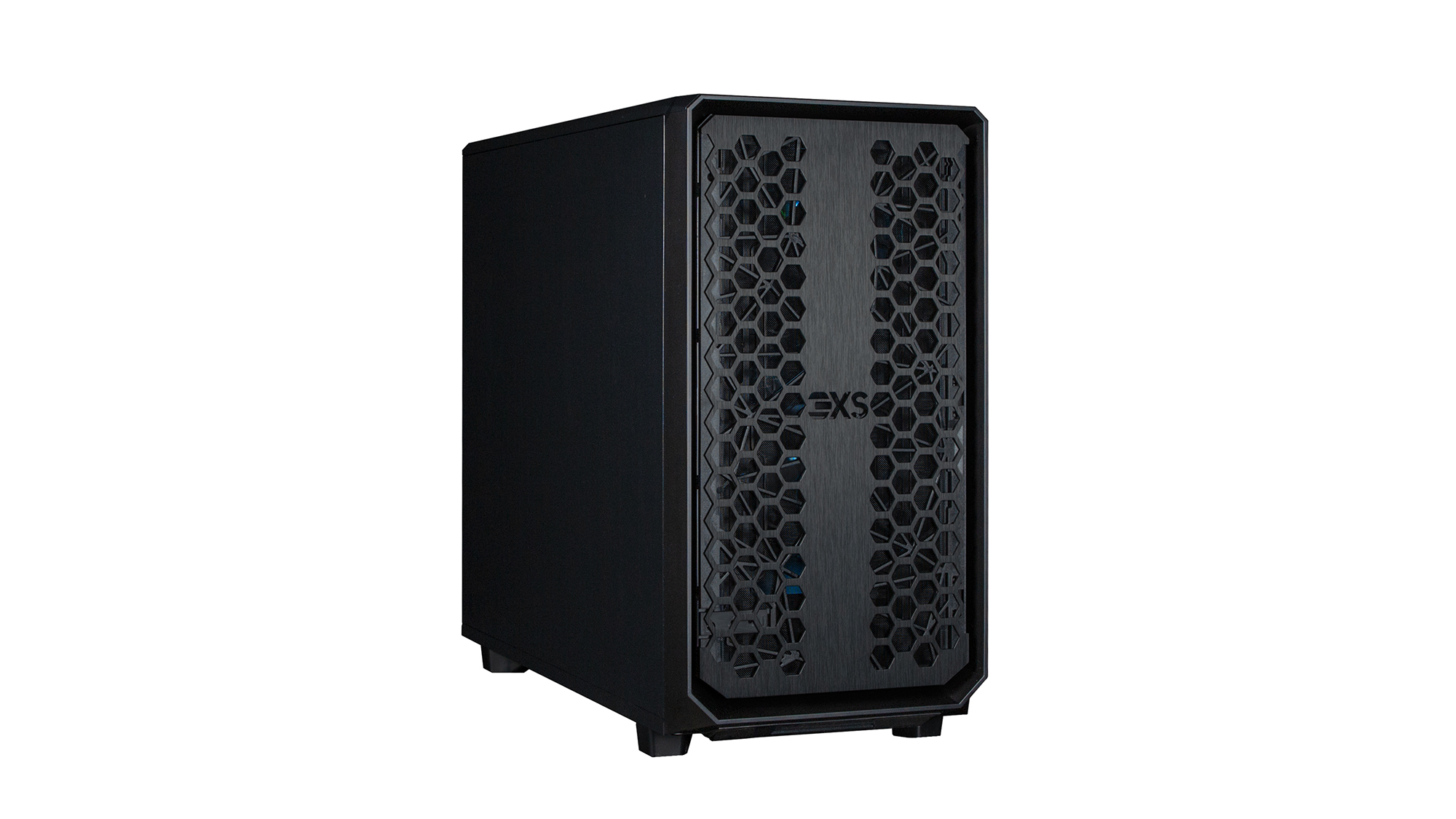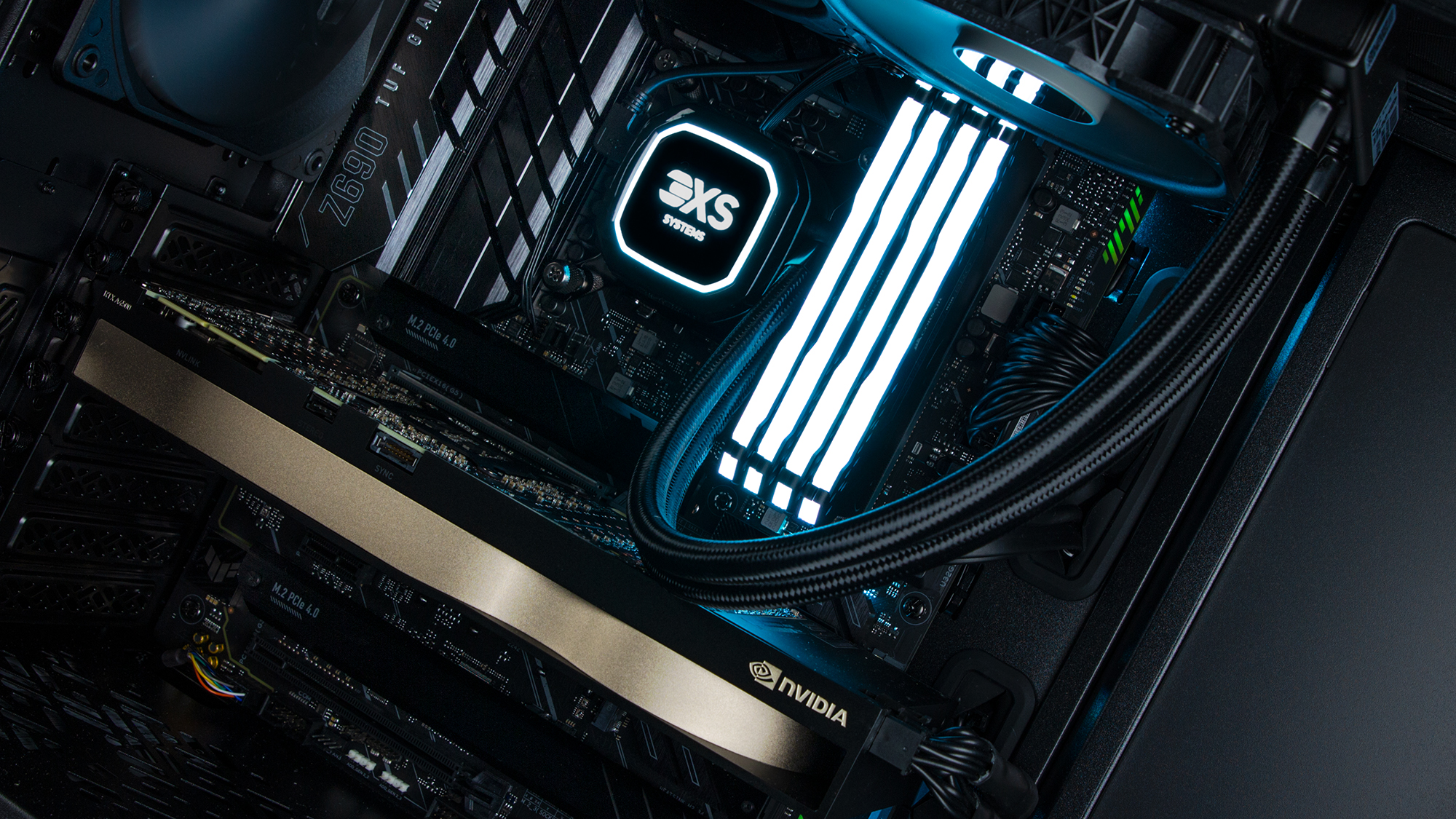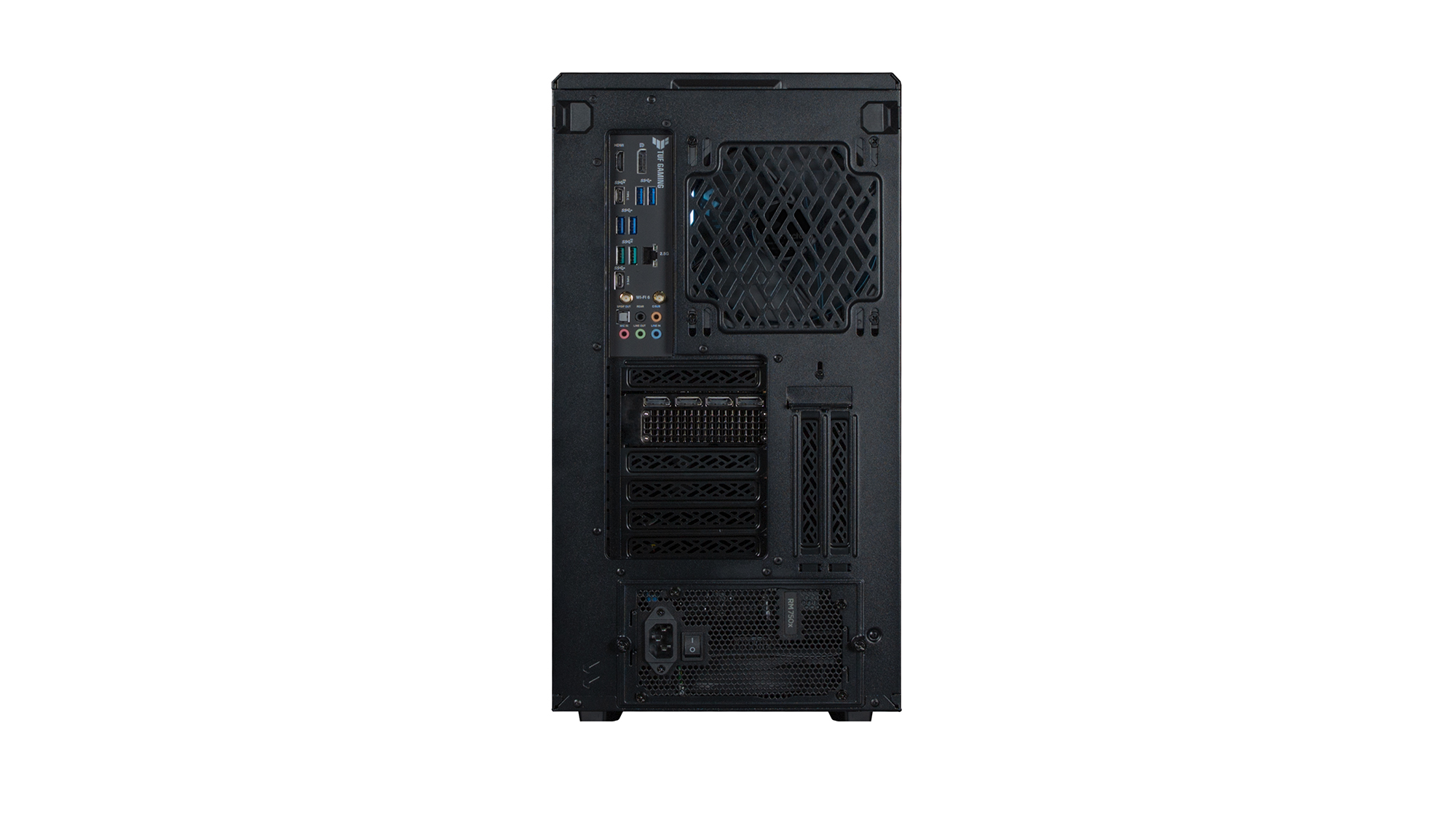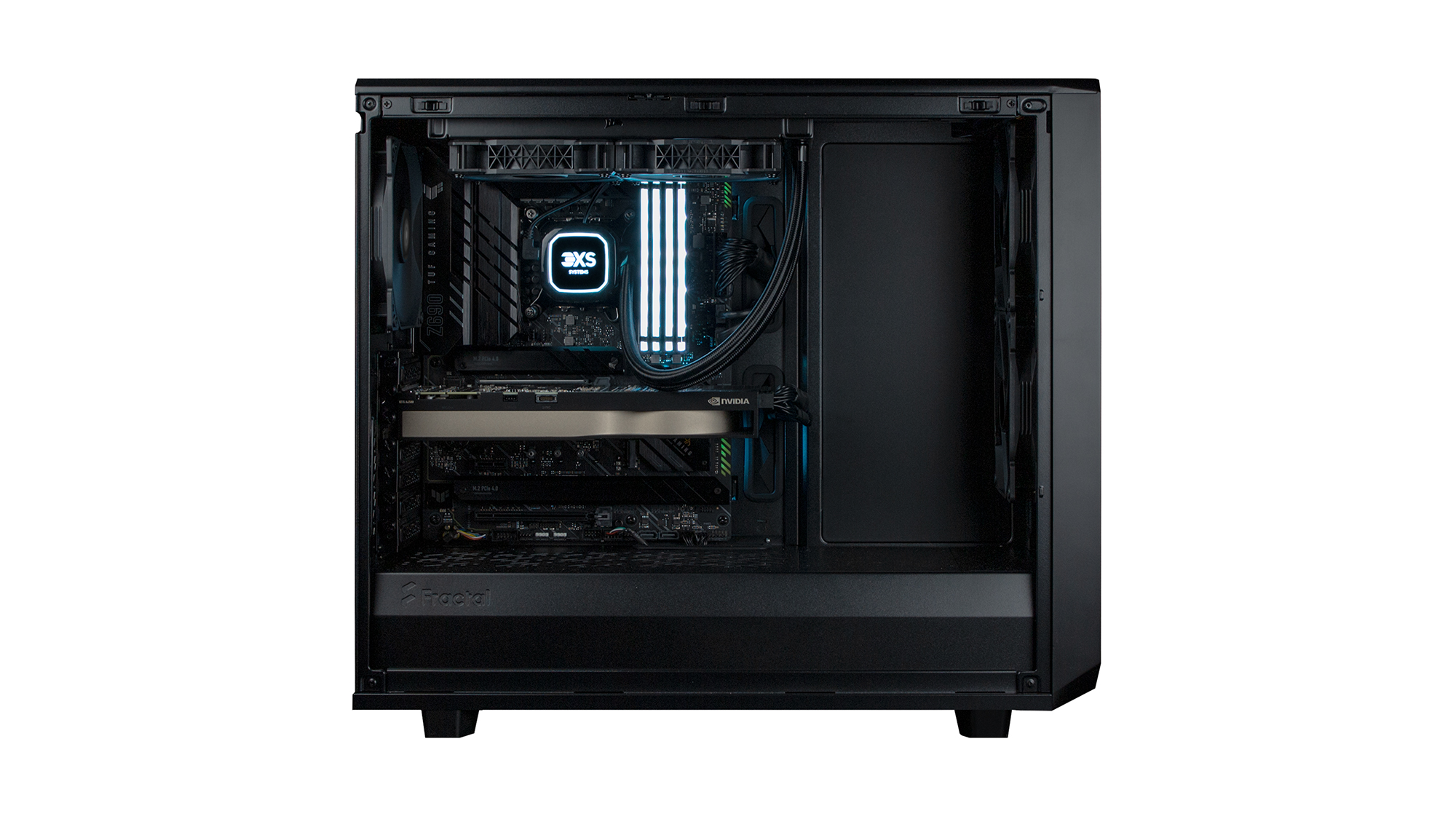Scan 3XS GWP-ME A124C review: An Intel-powered workhorse that holds its own
A brilliant content-creation showcase for Intel’s 12th-gen Core i9 and Nvidia’s Quadro RTX A4500 graphics


-
+
Highly expandable storage
-
+
Excellent performance for professional workloads
-
+
Phenomenal graphics performance
-
+
Good value
-
-
Motherboard doesn’t support DDR5

In recent years, Intel surrendered its long-held dominance in the workstation processor space to AMD. But now the regular Threadripper has been discontinued in favour of the feature-rich but more expensive Threadripper Pro, Intel is clawing its way back. The 12th generation of Intel Core processors, codenamed Alder Lake, has undeniably strong qualities – particularly for workstations and high-end desktops. And Scan’s 3XS GWP-ME A124C shows just how much Alder Lake has to offer content-creation professionals.
The central element of the A124C is its Core i9-12900K processor, which is one rung below the top 12900KS model. The novelty with Alder Lake is that it has two types of cores: high-performance P cores and power-efficient E cores. Only P cores support Hyper-Threading, so while the 12900K has 16 cores, it presents 24 threads. Clock frequencies are also different, with the 12900K’s P cores set at a nominal 3.2GHz with 5.1GHz boost, while the E cores start at 2.4GHz with a 3.9GHz max. The P cores also offer a 5.2GHz “turbo” capability.
This array of frequencies and features makes perfect sense for content creation. Software packages in this space either favour fewer cores with high frequencies, or they like lots of cores. Broadly speaking, 3D modelling, video editing and photo editing would be the former, and 3D rendering the latter. The i9-12900K offers the best of both these worlds.
Scan 3XS GWP-ME A124C review: Specifications
Although Alder Lake chips supports DDR5 memory, the Asus TUF Gaming Z690-Plus WiFi D4 motherboard supplied by Scan only allows DDR4. Scan populates it with 128GB of 3,200MHz modules, which may lose out on bandwidth to DDR5 but will last the lifetime of the system in terms of capacity. These are supplied as four modules, with four sockets lying empty, but as the motherboard maximum is 128GB you can’t upgrade any further. According to Scan, DDR5 is currently almost twice the price of DDR4, so it’s a sensible choice to go with the latter, as the performance loss isn’t huge.
One area where Scan has opted for the latest and greatest is graphics acceleration. This is the first system we’ve seen with the Nvidia Quadro RTX A4500. This includes faster core GPU and memory clocks than the Quadro RX A4000, but also more GDDR6 memory – 20GB instead of 16GB. The memory interface is 320-bit rather than 256-bit, so bandwidth overall is significantly increased from 448GB/sec to 640GB/sec. Meanwhile, Nvidia bumps up the number of CUDA cores from 6,144 to 7,168. As the model number implies, the RTX A4500 sits between the A4000 and A5000 in compute power and memory allocation. However, it’s a lot more expensive than the A4000, and would make up more than a third of the price of this system on its own.

The 12th generation Intel Core processors have leapfrogged AMD’s current generation not only by supporting DDR5 memory (even if our sample didn’t supply this) but also PCI Express 5.0, although you only directly benefit from this via the 16x PCI Express 5.0 slot used by the graphics card. However, support elsewhere for PCI-E Gen4 means that the NVMe storage can still operate at high speeds.
There are four M.2 slots on the Asus motherboard, and Scan has populated one with a 2TB Samsung 980 Pro Gen4 drive. Sustained read and write speeds of 6,667MB/sec and 4,944MB/sec respectively ensure that booting and app loading are quick. A capacity of 2TB is ample for a general content-creation system, but you should add a secondary AV drive for video editing. In this case, there are four SATA/600 ports on the motherboard, and the chassis provides a couple of 2.5in drive bays behind the motherboard for SATA SSDs.
Scan 3XS GWP-ME A124C review: Chassis design
The 3XS chassis is based around a Fractal Design Meshify 2. This has options for 3.5in bays but Scan hasn’t fitted these as standard. Instead, it leaves the chassis open to improve airflow. Should you want to prioritise storage, fear not: you can fit up to 14 drives via optional brackets, on top of up to four dedicated 2.5in mounts.
Unsurprisingly, liquid cooling is used to keep noise levels low, in the shape of a Corsair H100i Pro XT unit with a 240mm dual fan radiator. Power comes from a 750W Corsair RMX 80 Plus Gold supply, which is adequate for the components installed: we measured a peak of 515W when we pushed it in Blender, and it idles at a very reasonable 56W.
The top edge of the chassis includes discrete analogue audio minijacks for headphones and a microphone, USB-C and a couple of USB-A ports. These will be easily accessible if the case is on the floor by the desk side. Due to the sheer size of the chassis the rear will be tricky to access, but there are two more USB-C ports (one USB 3.2 Gen 2, so 10Gbits/sec, and one USB 3.2 Gen 1 at 5Gbits/sec) and six USB-A ports (two Gen 2, four Gen 1). You will also find connectors for Wi-Fi 6 aerials, 2.5Gb Ethernet, and six audio ports including S/PDIF.

Scan 3XS GWP-ME A124C review: Performance
If you look back at the professional workstations we’ve reviewed over the last few years, you’ll find almost all of them are united by one factor: AMD inside. That tells its own story. Finally, with Alder Lake, Intel has a chip that can compete at the “mid-range” point of £2,500 to £5,000.
In fact, the Scan’s overall score of 602 in the IT Pro benchmarks were just barely behind the Chillblast Fusion Threadripper Pro RTX 3975WXs Workstation’s score of 676, despite that system costing more than twice the price. The Scan’s results included 260 in image editing, 578 in video encoding and 731 in multitasking, more or less on par with Scan’s own Ryzen Threadripper 3970X-powered 3XS GWP-ME N1-32T. You can expect the slightly faster Intel Core i9-12900KS to pull ahead.
The Cinebench R20 score of 10,192 is also promising, albeit not quite ahead of the Armari Magnetar V16R-RD850G3 and its AMD Ryzen 9 5950X processor, which managed 10,972. Considering the 5950X is also a 16-core CPU, but with multithreading across all cores, Intel is doing well here.
Nvidia’s Quadro RTX A4500 graphics reign supreme, too. In SPECviewperf 2020, the 3XS managed 161 in the 3ds Max viewset and 468 in Maya, showing great 3D animation abilities. For engineering and CAD, 125 in Catia, 182 in Creo, 473 in Siemens NX and 302 in SolidWorks imply strong functionality with every platform.
The A4500 also packs potency for compute tasks. The LuxMark 3.1 result of 13,745 is well ahead of the 10,000-odd that’s typical of a Quadro RTX A4000 system, and not far off an A5000, which usually return a little under 16,000.

What we haven’t yet seen is a direct rival to AMD’s Threadripper chips. For example, the outstanding Workstation Specialists WS-1640A-G4 costs less than £5,000 before VAT– but in return you get the horsepower of a 3900X with its 64 cores and 128 threads, which still give it a comfortable lead in performance across almost all of our benchmarks, including more than 100 points in our in-house performance tests and a 250% increase on the 3XS’ Cinebench R20 score.
Scan 3XS GWP-ME A124C review: Verdict
If there’s one thing that’s clear from the Scan 3XS GWP-ME A124C, it’s this: Intel is back. The 12th gen Intel Core processor isn’t trouncing AMD just yet, but it’s beating it in some areas and holding its own elsewhere.
In the absence of AMD’s next generation of Ryzen chips, Intel has grabbed back its workstation crown at this price range. Nvidia retains its dominance, with the Quadro RTX A4500 providing another option between A4000 and A5000. And Scan has done an exemplary job of showcasing these components in the 3XS GWP-ME A124C, which we heartily recommend as a content-creation workhorse.
Scan 3XS GWP-ME A124C specifications
| Processor | 16-core (8 P-cores, 8 E-cores) Intel Core i9-12900K processor |
| Motherboard | Asus TUF Gaming Z690-Plus WiFi D4 |
| RAM | 128GB DDR4-3200 SDRAM |
| GPU | Nvidia Quadro RTX A4500 graphics with 24GB GDDR6 memory |
| Outputs | 4x DisplayPort 1.4 |
| SSD | 2TB Samsung 980 Pro M.2 PCI-E 4.0 SSD |
| Secondary drives | N/A |
| Optical drives | N/A |
| Dimensions (WDH) | 240 x 542 x 474 mm |
| PSU make and model (power output) | Corsair RMX PSU (750W) |
| CPU cooler | Corsair H100i Pro XT liquid cooler |
| Rear ports | 1x USB-C 3.2 Gen 2, 1x USB-C 3.2 Gen 1, 2x USB-A Gen 2, 4x USB-A Gen 1, 2.5GbE |
| Front/top ports | 2x 3.5mm jack (input/output), 1x USB-C, 2x USB-A |
| Operating system | Windows 11 Pro |
| Warranty (parts & labour unless stated) | 3yr warranty (1yr on-site, 2yr RTB, all include parts and labour) |
Get the ITPro daily newsletter
Sign up today and you will receive a free copy of our Future Focus 2025 report - the leading guidance on AI, cybersecurity and other IT challenges as per 700+ senior executives
Dr James Morris has worked as a technology journalist for over 25 years, including spending nine years on the staff of market-leading computer magazine PC Pro, the last five of which were as the publication’s editor. He specialises in enterprise-grade software and hardware, with a particular focus on content creation. He launched a pioneering video channel for HEXUS.net in 2006 and ran the video reviews channel for TrustedReviews.com for four years. He also runs a successful online digital content and commercial video production company, t-zero communications Ltd.
Dr Morris is a prolific technology writer and contributes commercial content for major IT brands including AMD, BlackBerry, Dell, Cognizant, HP, and IBM. He published a book on artificial intelligence, Can Computers Create Art? in 2009. He is also an academic, and is currently Pathway Director of the MA, Interactive Journalism at City, University of London.
Previously, he was course leader for the BA in Web Media Production at Ravensbourne University. He has a PhD in Philosophy, Art and Social Thought from the European Graduate School in Switzerland, a Master's in Media Arts from the New School in New York, USA, and a Bachelor's in Social Anthropology from the London School of Economics.
Dr. Morris can be found on Twitter at @Cyberwest, or emailed at j@tzero.co.uk
-
 Westcon-Comstor and Vectra AI launch brace of new channel initiatives
Westcon-Comstor and Vectra AI launch brace of new channel initiativesNews Westcon-Comstor and Vectra AI have announced the launch of two new channel growth initiatives focused on the managed security service provider (MSSP) space and AWS Marketplace.
By Daniel Todd Published
-
 Third time lucky? Microsoft finally begins roll-out of controversial Recall feature
Third time lucky? Microsoft finally begins roll-out of controversial Recall featureNews The Windows Recall feature has been plagued by setbacks and backlash from security professionals
By Emma Woollacott Published
-
 The UK government wants quantum technology out of the lab and in the hands of enterprises
The UK government wants quantum technology out of the lab and in the hands of enterprisesNews The UK government has unveiled plans to invest £121 million in quantum computing projects in an effort to drive real-world applications and adoption rates.
By Emma Woollacott Published